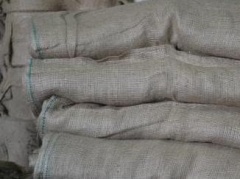Hessian
| Infobox on Hessian | |
|---|---|
| Example of Hessian |  |
| Facts | |
| Origin | - |
| Stowage factor (in m3/t) | 1,36/1,42 m3/t (bales) |
| Humidity / moisture | - |
| Ventilation | - |
| Risk factors | See text |
Hessian
Description
Hessian, or burlap in the US and Canada, is a woven fabric usually made from skin of the jute plant or sisal fibres, or may be combined with other vegetable fibres to make rope, nets, and similar products. Gunny cloth is similar.
Hessian, a dense woven fabric, has been historically produced as a coarse fabric, but more recently it is being used in a refined state known simply as jute as an ecofriendly material for bags, rugs, and other products.
The name "burlap" appears to be of unknown origin. The name "hessian" is attributed to the use of the fabric, initially, as part of the uniform of soldiers from the German state of Hesse who were called "Hessians."
Hessian is often used to make sacks and bags to ship goods like Coffee Beans; these can be described as gunny sacks. It is breathable and thus resists condensation and associated spoilage of the contents. It is also durable enough to withstand rough handling in transit; these properties have also led to its use for temporary protection as wet covering to prevent rapid moisture loss in setting of cement and concrete by the construction industry. Hessian is also commonly used for making sandbags, empty hessian sacks that, when filled with sand, are used for flood mitigation when building temporary embankments against floodwaters or field fortifications. Hessian was traditionally used as backing for linoleum, rugs and carpet.
Hessian cloths are used extensively for various purposes, ranging from commodities packaging to home décor. Due to natural bio-degradable feature, end users prefer to use hessian cloth over synthetic substitutes. Hessian cloths are finer in quality and are lighter in weight compared to the sacking cloth. Hessian cloths are quite popular in packing cotton, wool.
Shipment / Storage / Risk factors
A cloth woven from jute and usually shipped in bales. Bales of hessian cloth having internal yellow stains may have the appearance of contamination by salt water. These stains may be due to the thread used in the manufacture, which although of good quality, leaves patches of deep yellow colour, without in any way affecting the quality of the hessian. However, yellow staining does occur if hessian has been wet for some time – if such staining is in the middle of a bale without any direct link to external damage it could indicate dampness of cloth prior to baling. In such cases a fresh water reaction would result from silver nitrate test.
Although absolutely clean and dry and not subject to the provisions of the IMDG Code, hessian fabric can easily be ignited in contact with oxidizing agents, particularly liquids and may give rise to spontaneous combustion in contact with animal or vegetable oil. Hessian fabric is used as "backing" in the carpet industry.
The large rolls should be handled and stowed with care to avoid deformation.
Bales of hessian cloth having internal yellow stains may have the appearance of contamination by salt water. These stains may be due to the thread used in the manufacture, which although of good quality, leaves patched of deep yellow colour, without in any way affecting the quality of the hessian. However, yellow staining does occur if hessian has been wet for some time – if such staining is in the middle of a bale without any direct link to external damage it could indicate dampness of cloth prior to baling. In such cases a fresh water reaction would result from silver nitrate test.











